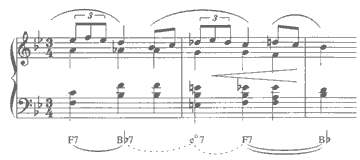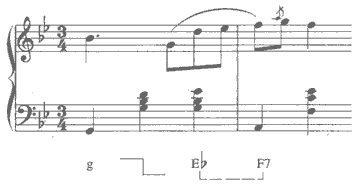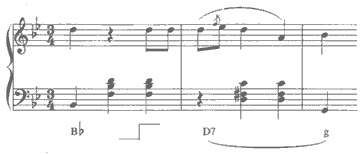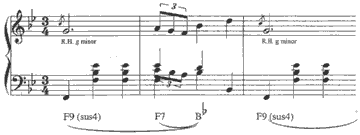Musical Insights, Vol. 1 (Spring 1997) [Prev] [Next] [MACRO] [Journal Home] [Submissions]
When George Sand ended her relationship with Chopin it marked the beginning of the last stage of his career. His health began to deteriorate rapidly. He quit performing and teaching and had little desire to compose. His last works, the op. 67 Mazurkas, were written for his own pleasure and reaffirmed his strong emotional and patriotic ties to his native Poland. This Mazurka was written in 1849 shortly before his death and published posthumously in 1855. Op. 67 is a set of four simple works with related keys: G major, G minor, C major and A minor.
The present work in G minor does not demonstrate the more innovative harmonic and pianistic techniques for which Chopin is famous. It is, however, a charming and intimate example of his ability to combine a playful and lyrical melody in the right hand while establishing a well-grounded accompaniment in the left hand. The work has the following form:
| A | B | transition | A | |
|---|---|---|---|---|
| Key: | G minor | B-flat major | G minor | |
| Measures: | 1-16 | 17-32 | 33-40 | 41-56 |
This simple composition has several elements which make it a good example for macro analysis. There are twelve circle progressions in the first sixteen measures alone. The B section has a circle progression in every single measure including an uninterrupted chain of ten dominant 7th chords which leave and return to the tonic B-flat giving us a rather complete tour of the entire circle of fifths using only one tritone substitution (from G-flat to C) along the way.
My analysis includes some symbols which deviate only slightly from the "standard" macro
symbols (i.e., curved lines or slurs to identify root movement down a fifth).
The bracket ![]() likewise
indicates roots down a fifth when the left chord is minor (as in d
likewise
indicates roots down a fifth when the left chord is minor (as in d![]() G
G![]() C).
This is especially useful in jazz and in setting up cadences where the common
ii
C).
This is especially useful in jazz and in setting up cadences where the common
ii![]() V7
V7![]() I
progression is so often found. The dotted curved line is used where chords have
a pulling tendency, but do not have a root progression of down a fifth--such
as resolutions of up a half step (leading tone progression), down a half step
(Phrygian leading tone or Neapolitan progression) and tritone progressions. These
are "quasi dominant" progressions and so they use a "quasi" curved
line (see measures 30 and 31, example 1).
I
progression is so often found. The dotted curved line is used where chords have
a pulling tendency, but do not have a root progression of down a fifth--such
as resolutions of up a half step (leading tone progression), down a half step
(Phrygian leading tone or Neapolitan progression) and tritone progressions. These
are "quasi dominant" progressions and so they use a "quasi" curved
line (see measures 30 and 31, example 1).

Example 1. "Quasi dominants.", Measures 30-31.
Similarly, while a ii![]() V
V![]() I
progression is all down a fifth, a IV
I
progression is all down a fifth, a IV![]() V
V![]() I
has the same effect so the IV to V uses a similar dotted bracket as a "quasi
pre-dominant" progression (see measure 2, example 2).
I
has the same effect so the IV to V uses a similar dotted bracket as a "quasi
pre-dominant" progression (see measure 2, example 2).

Example 2. "Quasi pre-dominant.", Measures 2-3.
A common technique for "slipping" from one circle progression to
another is the use of substitute chords. These are chords with two common tones
(C-a, C-e). Substitute chords are sometimes called chromatic sliding or chromatic
shifting if there is only one common tone because another tones moves chromatically
(C-A, etc.) These substitute chords have roots a third apart. For example, in
measure 12, Chopin cadences in B-flat and then uses a substitute chord (D) to
start the next circle progression (see example 3). If the root moves up a third
the symbol is ![]() .
If the root moves down it is
.
If the root moves down it is ![]() .
.
I do not believe that progressions of up and down a step need to be indicated, nor do the "anti-circle" progressions of down a fourth. These progressions do not have forward harmonic motion and are not subtle. They can only build anticipation through repetition--a device often used in rock music. I am mildly concerned that any additional symbols (other than curved lines) may actually defeat the beautiful simplicity of the macro analysis system. When only circle progressions are labeled, they emerge with just a cursory glance. Having a symbol for every possibility may easily cloud the issues and defeat our purpose.

Example 3. Substitute chords. Measures 12-14.
I will end with a couple of other little observations about the piece. Measures 17 and 19 have chords which are open to interpretation (see example 4). They are probably best described as F9 (sus4) chords, but they could also be seen as early examples of quartal harmonies with an added third above the E-flat (a common technique with Hindemith).

Example 4. Measures 17-19.
Or a less-likely explanation is that Chopin delved into bi-tonality with the left hand in B-flat and the right hand still in G minor. Finally, if you look only at the grace notes in the piece you will see that they are all chord factors of the Fmaj7th chord (even as in measure 1 where the grace note is an F-natural and the harmony has an F-sharp). And since grace notes always get special emphasis perhaps on a subliminal level Chopin really wrote this piece in F Mixolydian! Unlikely, but that would make a tremendous difference if we were using roman numerals, whereas with macro analysis, the harmonic relationships remain unchanged.